 Full details on Yamaha’s 2009 R1 1000cc rocket.
Full details on Yamaha’s 2009 R1 1000cc rocket.

2009 Yamaha R1
Yamaha have released details on the 2009 R1, in the form of the following press release:
YMA plans to release its all new revolutionary YZF-R1 at the end of February 2009. The radical and innovative new model represents the most significant development in engine and chassis technology ever seen in the 11-year history of this legendary motorcycle.
Since the original YZF-R1 was released into an awe-struck marketplace, Yamaha’s flagship 1000cc model has established a reputation as being one of the most innovative and exciting motorcycles in the largecapacity supersport class. For 2009 that outstanding reputation is sure to be further reinforced.
Featuring an all-new 998cc engine whose design, feel and character has been influenced by Rossi’s championship winning M1, the new high-tech R1 powerplant is closely linked to our Moto GP bike. In fact the 2009 model R1 engine has benefited from more Moto GP developed technology than any other in its long and prestigious history. In addition, the completely redesigned aluminium Deltabox chassis and aggressive new styling, give the new-generation YZF-R1 a radical new look and bring innovative technology to the class. In the same way that the original YZF-R1 threw the rule book out of the window, this revolutionary new model sets a new benchmark for the super-competitive 1000cc supersport category.
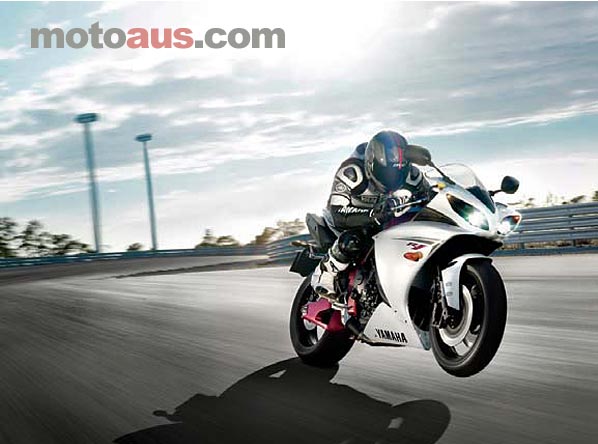
Crossplane crankshaft engine
Crossplane crank technology is used for the first time in a production motorcycle to offer riders unparalleled levels of control Rather than look exclusively to additional electronic aids to further enhance the new YZFR1’ s performance and controllability, Yamaha’s engineers have opted for a mechanical solution. The defining and most influential feature of the new YZF-R1 is the use of an innovative new 998cc engine which has been developed from our winning YZR-M1 Moto GP design.
Undoubtedly the single most significant piece of technology to be seen on this compact new high-performance engine is its race-developed crossplane crankshaft, which delivers outstandingly pure torque characteristics and high levels of traction. Indeed, the new engine’s linear and controllable torque characteristics are the very essence of this radical new generation YZF-R1.
The new engine’s uneven 270° – 180° – 90° – 180° firing interval creates a whole new feel to the inline 4-cylinder engine, giving the new YZF-R1 rider a more precise and immediate feeling of control over the torque output levels. In addition, the new engine’s linear torque delivery gives rise to a confidence-inspiring sensation that makes each throttle input, however subtle, feel as though it is transmitted directly to the rear tyre. The result of this rider-responsive torque is an enormously capable 1000cc supersport motorcycle that is designed to deliver previously unattainable levels of traction for unrivalled cornering performance.
To accentuate the performance gains of the new crossplane crankshaft engine, we have also developed a new short-wheelbase aluminium Deltabox chassis and optimised the front and rear suspension systems. And the radical and aggressive new styling emphasises the new YZF-R1’s concentration of mass.
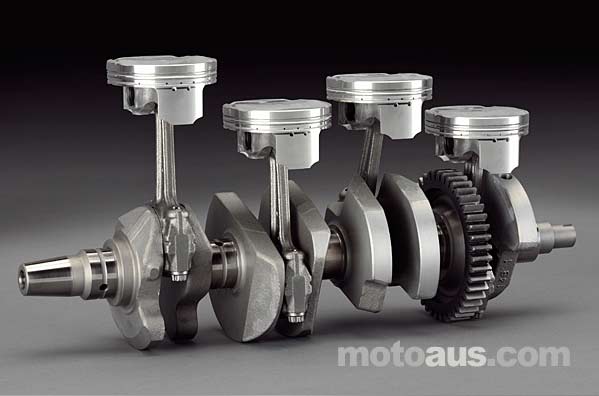
This remarkable new 998cc liquid-cooled inline 4-cylinder 4-valve engine features bore x stroke dimensions of 78.0 mm x 52.2 mm, giving an extremely short stroke layout, together with the largest bore dimensions ever used on a Yamaha 1000cc supersport engine. In association with the short stroke and big bore, a high compression ratio of 12.7:1 is featured, which contributes to the new engine’s impressive power output of 182 PS at 12,500 rpm, and a torque output of 115.5 Nm (11.8 kg-m) at 10,000 rpm with natural aspiration.
Undoubtedly the most significant change for 2009 is the use of an all-new crossplane crankshaft which is based on the advanced race-bred technology that was originally developed for the Yamaha YZR-M1 MotoGP racing machine. This new crossplane crankshaft has been introduced in order to enable the new engine to produce more linear torque characteristics, together with more accurate and linear throttle control (see sidebar on right for explanation).
The new engine’s linear power characteristics deliver a 1:1 relationship between the rider’s throttle input and the engine’s output to the rear tyre, and it is this crucial aspect of the new bike’s character that allows the rider to experience a new of level of cornering performance, together with outstanding traction when entering the mid-section of a corner, and also when accelerating out of a bend.
Another feature of the crossplane crankshaft with uneven firing interval is the very special exhaust note that this layout produces, and the new 2009 YZFR1 engine note has much in common with the YZR-M1 racing machine.
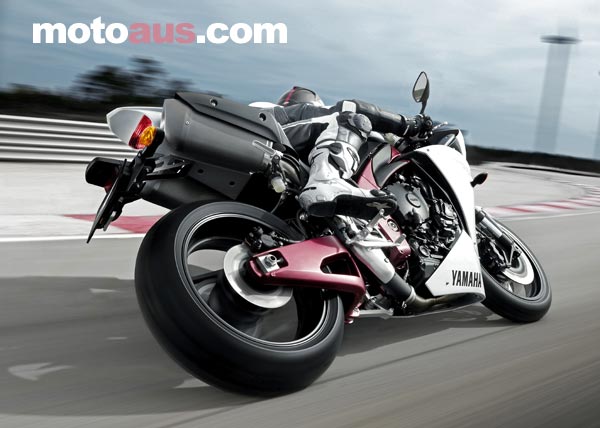
The new YZF-R1 is equipped with lightweight forged aluminium pistons which have been manufactured using the same process as the 2008 YZFR1. During the special forging process, the aluminium alloy is not actually melted, but is only heated to the temperature where it can be shaped under pressure in the forge. This system allows the aluminium to retain more of the original strength of the metallurgic matrix, which enables our engineers to specify a lighter piston design, thereby reducing reciprocating weight and enhancing throttle response.
The new lightweight ceramic-composite plated cylinder provides excellent heat dissipation together with an outstanding rigidity balance. This new short-stroke cylinder features a closed-deck design in which the coolant passages do not pass from the cylinder into the cylinder head, and this makes for high levels of reliability in this type of high compression inline 4-cylinder engine.
The new short-stroke engine also benefits from shorter cylinder stud bolts which gives a weight reduction, and at the same time helps reduce overall engine height to give compact overall dimensions.
The 2009 model YZF-R1 is equipped with fracture-split (FS) carburised con rods, a system that has been used successfully by Yamaha since the 2004 model YZF-R1. The two halves of each fracture-spit big end ring are re-assembled along the same fracture lines, and this makes for a stronger and more perfectly round big end, giving outstanding performance and reliability.
The all-new YZF-R1 engine design is equipped with a larger 36 mm crank journal (compared to 32 mm diameter on the 2008 model YZF-R1) which is designed to handle the new power and torque characteristics of the crossplane crankshaft.
YCC-I (Yamaha Chip Controlled Intake) The YCC-I system features electronically-controlled intake funnels whose length can be varied to suit the prevailing engine speed in order to provide good intake pulsation. At low to mid engine speeds the long and short funnels operate as a single connected unit, but when the engine speed exceeds 9400 rpm the YCC-I on the new YZF-R1 engine automatically separates the lower funnel and upper funnel by means of an electronically-controlled servomotor. By varying intake length to suit engine rpm, the YCC-I system enables the new YZF-R1 engine to operate more effectively across the rpm band, and the funnel separation process is so smooth that the rider is unaware it has happened.
YCC-T (Yamaha Chip Controlled Throttle) The advanced YCC-T electronic throttle system delivers outstanding controllability at all speeds, and helps to prevent any hesitation caused by an excessive fuel/air supply when the throttle is opened suddenly. The system adjusts the throttle valve opening via a servomotor at intervals of 1/100th of a second. By constantly calculating and adjusting the optimal throttle opening and intake air volume to match the prevailing engine running conditions, the YCC-T consistently ensures that the new YZF-R1 engine produces an optimum drive torque curve – and the ignition timing is mapped separately for each cylinder in order to ensure efficient combustion processes. Fuel injection system with secondary injector The YCC-T operates a highly-efficient twin injector type fuel injection system which is designed to deliver outstanding throttle response and remarkable performance at all riding speeds. This twin injector system features a main injector together with a secondary injector, which is situated at the upper edge of the funnel. The secondary injector comes into operation in the engine’s mid to high-speed range to complement the main injector, and this design ensures remarkable response and outstanding acceleration and performance.
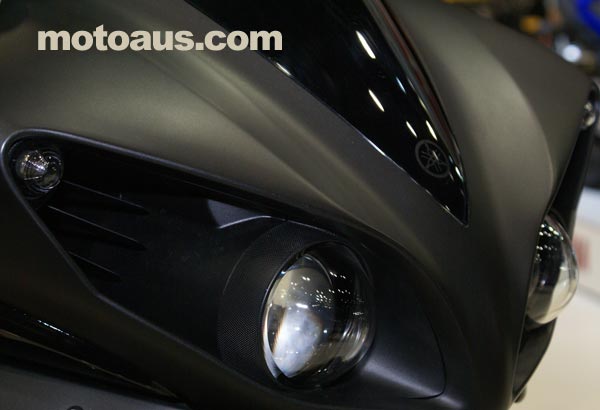
For the first time on a Yamaha supersport model, the new YZFR1 is equipped with a D-mode Map which works in association with the YCC-T (Yamaha Chip Controlled Throttle) and allows the rider to select a performance profile to match their requirements. The D-mode Map consist of three modes which are: Standard mode; A mode; and B mode; and the rider can choose which mode is best suited to the prevailing riding conditions by operating a switch on the handlebars. Standard mode is mapped to give optimum all-round performance, while the A mode delivers sharper engine response, and the B mode gives a gentler response to the rider’s throttle inputs.
The redesigned forced air intake system utilises the natural airflow to increase the pressure of the air in the airbox, and this ensures increased levels of power at higher speeds for outstanding performance. This system takes air in through the front cowl, and channels it via the left and right sides of the new frame, directly into the airbox. For 2009 the YZF-R1’s forced air intake system incorporates special new side branches which reduce intake noise.
For even more stable handling performance when decelerating during quick downshifting, the 2009 YZF-R1 is equipped with a slipper clutch. This clutch features a mechanism that adjusts clutch spring load when excessive torque is transferred from the rear wheel to the crank when the rider changes down through the transmission. By controlling excessive engine braking forces, this system enhances overall controllability.
In order to ensure an effective exhaust pulsation to complement the new engine’s crossplane crankshaft, an all-new exhaust system is fitted, in which the exhaust pipes for the 1st and 4th cylinders and for the 2nd and 3rd cylinders are brought together in a 4-2-1-2 layout. This high performance system features a 3-way catalyser positioned at the point where the four exhaust pipes meet, and outstanding environmental performance is ensured by an O2 sensor linked to the ECU which constantly adjusts the fuel/air mix in order to minimise harmful emissions. The stylish triangular-shaped mufflers emit a sharp, gutsy exhaust note which complements the unique pulse created by the asymmetric firing sequence of the new crossplane crankshaft. The triangular design also contributes to the tighter and more compact body design of the all-new YZF-R1, while at the same time giving the bike’s rear end a sharp new look.
Engine Technical Highlights
Moto GP-developed 998cc liquid-cooled inline 4-cylinder 4-valve DOHC
182 PS at 12,500 rpm without ram air
115.5 Nm (11.8 kg-m) at 10,000 rpm
Short-stroke, big-bore design
Bore x stroke 78.0 mm x 52.2 mm
Crossplane crankshaft Uneven 270º – 180º – 90º – 180º firing interval
Newly-developed forged aluminium pistons
Closed-deck ceramic-composite plated cylinder
Fracture split (FS) carburised con rods
Optimised large-diameter crank journal and flywheel mass
YCC-I (Yamaha Chip Controlled Intake)
YCC-T (Yamaha Chip Controlled Throttle)
Fuel injection system with secondary injector D-mode
Map Redesigned forced air intake
Slipper clutch
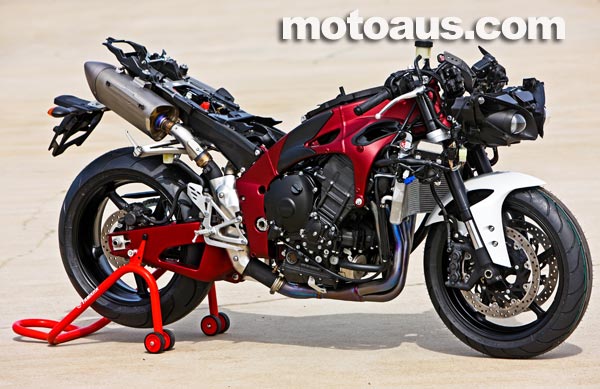
Chassis
The 2009 YZF-R1 runs with a completely new aluminium Deltabox frame which has been designed to deliver class-leading handling and cornering performance. Particular attention has been paid to achieving a handling character which allows the rider to fully utilise the new linear torque characteristics and high levels of traction delivered by the new crossplane crankshaft engine. With the exception of the internal forced air intake ducts, the newly designed Deltabox frame is virtually completely different to the 2008 design, and as well as featuring a new shape with different dimensions, the type of aluminium used and the frame’s overall rigidity balance are also changed for 2009.
The new frame uses a combination of different types of aluminium to achieve the desired balance of rigidity. Gravity cast parts are used for the head pipe as well as the engine mount assemblies and the pivot support assembly, while the outside tank rails are made from CF die-cast aluminium which allows the use of much thinner walls.
By using a combination of lightweight parts with different characteristics, Yamaha’s engineers have succeeded in creating a new Deltabox frame which delivers an idealised balance of rigidity. For 2009, the new YZF-R1’s lateral rigidity has been adjusted, and as well as enhancing high speed stability, this feature also helps improve overall handling performance, particularly in terms of enabling effective traction when exiting a curve. The engine is a stressed member of the frame, and the engine mounts are rigid types, with two on the upper crankcase and two on the lower crankcase, and two at the right and left ends of the cylinder head.
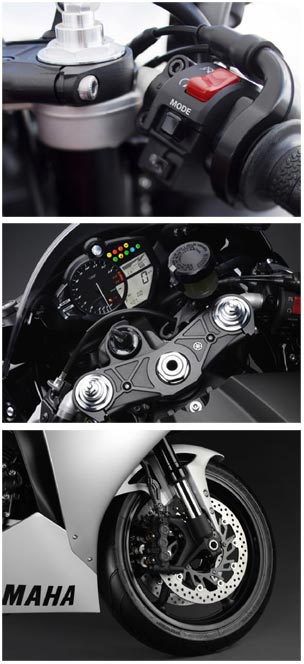 The new frame uses extremely strong cast parts at the head pipe, swingarm pivot and engine mounts, while the die-cast and extruded aluminium structures that connect them are given a degree of forgiveness. This unique combination of rigid and slightly less rigid aluminium components are what give the new YZF-R1’s Deltabox frame such a special character, which allows the rider to explore the full potential of the machine’s outstanding performance. In addition, the idealised balance of rigidity on this innovative new frame also enhances the very special direct torque feeling associated with the exciting new crossplane crankshaft engine, making the new YZF-R1 a truly unique riding experience.
The new frame uses extremely strong cast parts at the head pipe, swingarm pivot and engine mounts, while the die-cast and extruded aluminium structures that connect them are given a degree of forgiveness. This unique combination of rigid and slightly less rigid aluminium components are what give the new YZF-R1’s Deltabox frame such a special character, which allows the rider to explore the full potential of the machine’s outstanding performance. In addition, the idealised balance of rigidity on this innovative new frame also enhances the very special direct torque feeling associated with the exciting new crossplane crankshaft engine, making the new YZF-R1 a truly unique riding experience.
The new R1 engine is mounted 9 degrees more upright than the 2008 model, and the cylinders are angled forward at 31 degrees. Also, the engine mounting position is 12 mm further forward in relation to the drive axis than the 2008 YZF-R1, and this factor helps contribute towards making the front wheel feel even more ‘stuck’ to the road. And with the new pivot position set a few mm lower than previously, transfer of drive force to the road surface is improved. These factors, together with a new fuel tank design, have come together to create a centre of gravity that is slightly lower than the existing model, giving optimised handling performance.
To illustrate the new bike’s compactness, an imaginary triangle created by joining the front and rear tyre contact patches with the centre of gravity is smaller than on the 2008 YZF-R1. This compactness makes for agile handling performance, and allows the rider to make full use of the linear torque and high traction when powering out of bends.
Concentration of mass has been a significant feature on all R-series supersport machines, and the new YZF-R1 takes the concept one step further with the fitment of a newly-designed large-capacity fuel tank. The press-formed shape was developed using 3-D simulation analysis technology, and this has enabled our engineers to create a larger, elongated fuel tank which sits neatly within the new twin spar aluminium Deltabox frame. With a capacity of 18 litres, the shape and position of the new fuel tank helps to improve concentration of mass, and its central location helps to minimize any variation in the new YZF-R1’s handling characteristics as the amount of fuel in the tank decreases.
By using lightweight materials for those components that are furthest from the machine’s centre of balance, Yamaha’s engineers have been able to enhance the YZF-R1’s concentration of mass even further. The magnesium rear frame made its debut on the 2008 model R6, and its use on the YZF-R1 takes the concentration of mass on this new generation one litre supersport machine to a new level.
The proven and successful combination of a short wheelbase and long swingarm has been a feature on all YZF-R1 models since the machine was launched. A short wheelbase is associated with high levels of agility and good manoeuvrability, while a long swingarm which pivots close to the machine’s mid-way point helps to deliver excellent stability during acceleration. In addition, because the YZF-R1’s long swingarm features a pivot point which is located close to the axis of the final drive sprocket, rear suspension squat during hard acceleration is minimised.
For 2009 the swingarm features a gravity-cast pivot assembly, while the arm and end-piece is a single-unit CF die-cast assembly. As a result of these changes, the weight of the new swingarm is reduced, and the rigidity balance has been optimised. This new swingarm design helps to ensure responsive suspension action and enhanced handling performance, especially when the YZF-R1 rider is exiting fast from a corner.
The adjustable rear shock absorber is equipped with both low and highspeed compression damping adjustment, allowing the rider to set the machine up to suit their individual needs and different riding conditions. The new bottom-link type suspension has been developed to make the most effective use of the 120 mm stroke, allowing the shock absorber to function efficiently for a stable and smooth riding experience.
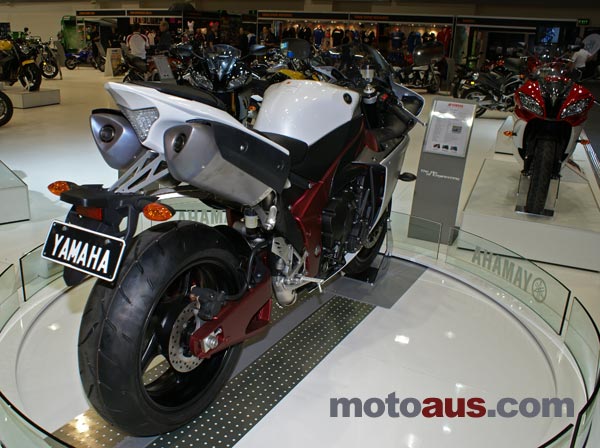
Surface feedback and damper response are all improved by the use of a new pillow-type ball joint in the rear shock, and for ease of adjustment, a hydraulic-type adjuster is fitted. Furthermore, bottom-link system enables to lower the mounting location of the rear suspension, and contributes to concentration of mass by setting the fuel tank in the vacant space.
Like the 2008 model, the new YZF-R1 is equipped with 43mm diameter front forks, but they are of a completely different design to previous suspension systems used on our R-series models. For 2009 the rebound and compression damping functions are separated, with the left fork equipped with the compression damping valves, and the right fork equipped with the rebound damping valves. This system offers a number of advantages, including the simplification of valve designs and oil flows, as well as minimizing cavitations during successive strokes, and easier adjustment. Separating the damping functions has also enabled our engineers to increase the diameter of the internal cylinders which helps to stabilize various pressure variances.
This increase in cylinder diameter and oil volume also ensures that there is always sufficient oil available to deliver effective damping force for even the smallest front suspension Lightweight front discs allow quicker directional changes. Six pot dual pad radial mounted brakes offer incredible power and feel movements. Simpler, more effective and easier to adjust, the new front suspension system offers a clear advantage to the YZF-R1 rider.
The R-series models are famous for their class-leading braking performance, and the new YZFR1’ s compact system has been designed to offer optimum levels of braking power and controllability. The new front braking system features 310 mm dual discs which are slowed by dual six-piston calipers each containing four pads. The lighter front discs reduce the inertial moment around the axle, which reduces the gyro effect of the front wheel to give lighter, more agile handling and quicker directional changes.
In addition, the inner rotor has been redesigned to give the desired amount of play to promote stable braking force, and a newly designed front brake lever offers improved operability and feel. The rear brake features a 220mm diameter disc and single-piston pin-slide caliper with an aluminium piston, giving good braking operation and controllability.
The cooling system on the new YZF-R1 features a number of innovations, and a unique feature of this advanced new design is the use of lightweight plastic resin piping between the curved radiator and engine. This durable plastic piping has been manufactured using the ‘floating core’ method which makes for a lightweight structure, and this is the first time that this weight-saving technology has been used on a production motorcycle*.
By locating the inner cowl as close as possible to the engine, a passage has been created to channel the air after it has passed through the radiator and the two compact fans. At the same time, the negative pressure created along the surface of the middle cowl by the external airflow is actively used to draw this hot air away from the machine, resulting in more effective heat dissipation. Cooling efficiency is further improved by the fact that sufficient space is available between the inner cowl and the engine to allow the heated air to escape with ease. (*) As of Sept. 2008, based on Yamaha Motor study
Yamaha Motor Engineering, which is wholly owned by Yamaha, is the only officially-approved supplier of racing parts for the R-series machines, offered under the label ‘YEC Racing Parts’. For 2009 the YEC Racing Parts range includes highly advanced engine and chassis parts which are designed to transform the class-leading YZF-R1 into a full-on race bike which has the potential to win at the very highest level.
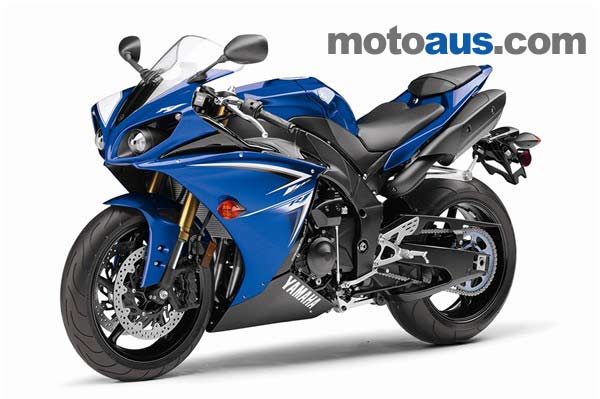
YEC Racing Parts are used by Yamaha’s winning superbike, supersport, superstock and endurance teams, and the very same parts that have helped these teams to numerous successes over the years are now available to the non-factory rider. Development and manufacturing is fully done in-house, using the experiences and input from our World Superbike and World Supersport teams and our development riders. All YEC Racing Parts meet Yamaha’s rigorous corporate standards, ensuring that with YEC, the customer will only get the highest quality products for their YZF-R1.
